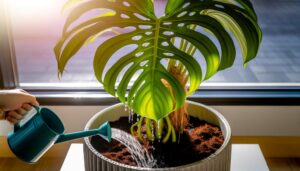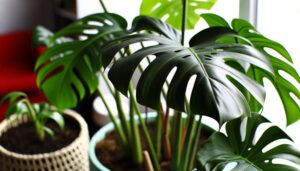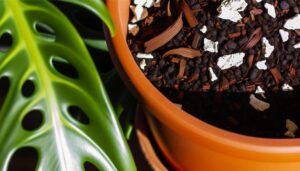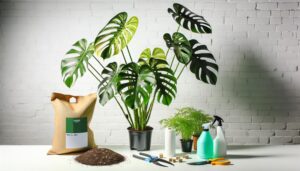White Variegated Monstera Adansonii Obliqua
The White Variegated Monstera adansonii obliqua, originating from the rainforests of Panama, Colombia, and Brazil, is prized for its delicate fenestrated leaves and unique white variegation caused by a genetic mutation affecting chlorophyll production. These epiphytic plants thrive in humid environments with temperatures between 18-27°C and humidity levels of 60-80%.
Position them in bright, indirect light and use well-draining, organic soil. Water every 7-10 days using filtered or rainwater to prevent root rot.
Interested in learning the best propagation techniques and care tips to keep your Monstera thriving?
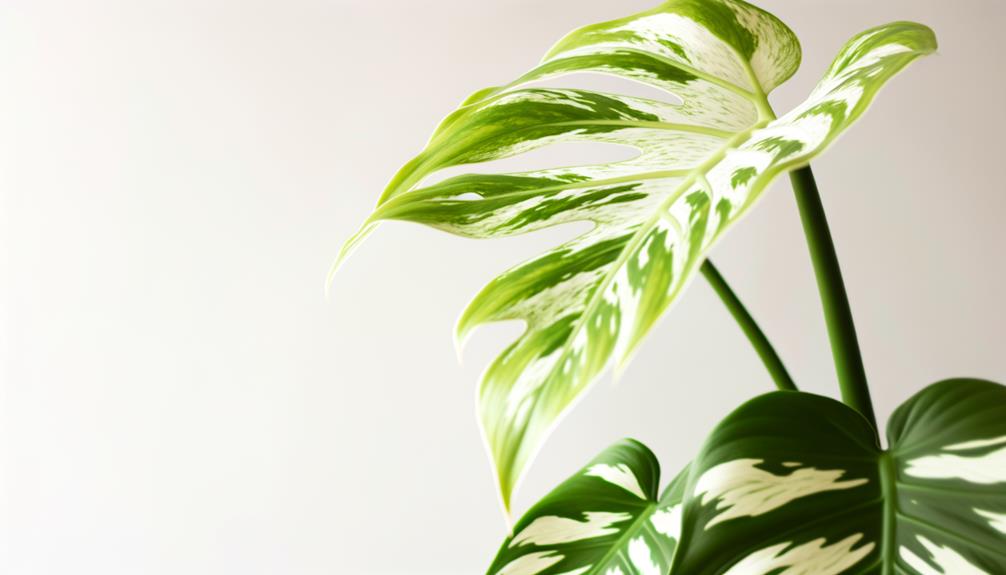
Key Takeaways
- White Variegated Monstera adansonii obliqua features fenestrated leaves with a distinctive white variegation due to a genetic mutation.
- The plant thrives in warm, humid conditions with bright, indirect light and well-draining, organic-rich soil.
- Regular watering every 7-10 days and maintaining 60-80% humidity levels are crucial for healthy growth.
- Propagation is best achieved using stem cuttings with nodes and aerial roots, placed in water until roots develop.
- Prices range from several hundred to thousands of dollars, depending on variegation, leaf count, and maturity.
Origins and History
The White Variegated Monstera adansonii obliqua, a rare cultivar of the Monstera adansonii species, traces its origins to the tropical rainforests of Central and South America. You'll find this plant residing in humid, shaded understories where it thrives in rich, loamy soil.
Indigenous to regions such as Panama, Colombia, and Brazil, it's well-adapted to a warm, moist environment. The plant's epiphytic nature allows it to climb trees, using aerial roots to anchor itself. Unlike terrestrial plants, it absorbs nutrients and moisture from the air. This adaptation is essential for its survival in dense forests where competition for sunlight and soil nutrients is fierce.
Understanding its origins helps you appreciate its unique growing requirements and ecological niche.
Unique Characteristics
Given its origins in the tropical rainforests, the White Variegated Monstera adansonii obliqua exhibits several unique characteristics, including its striking fenestrated leaves and distinctive white variegation that results from a genetic mutation. This rare variegation manifests as irregular patterns of white and green on the leaves, reducing chlorophyll production and growth rate.
Key characteristics include:
- Fenestrations: The leaves feature large perforations, optimizing light capture and reducing wind resistance.
- Variegation: The striking white and green patterns arise due to a lack of chlorophyll in certain leaf areas, making each leaf uniquely patterned.
- Thin Leaf Structure: The leaves are noticeably thinner compared to other Monstera species, contributing to their delicate and airy appearance.
These traits make the White Variegated Monstera adansonii obliqua a highly sought-after specimen for plant enthusiasts.
Ideal Growing Conditions
To thrive, Monstera adansonii obliqua variegata requires a carefully controlled environment that mimics its native tropical rainforest habitat. You should maintain temperatures between 18-27°C (64-81°F) and achieve high humidity levels, ideally between 60-80%. Position the plant in indirect, bright light to stimulate variegation while avoiding direct sunlight, which can scorch the leaves. Use well-draining soil rich in organic matter to support root aeration and prevent waterlogging.
| Factor | Ideal Condition | Description |
|---|---|---|
| Temperature | 18-27°C (64-81°F) | Maintain consistent warmth |
| Humidity | 60-80% | High humidity for best growth |
| Light | Bright, indirect light | Avoid direct sunlight to prevent leaf damage |
| Soil | Well-draining, organic | Supports root health and prevents waterlogging |
| Air Circulation | Moderate | Guarantees healthy respiration and reduces pest risks |
These conditions will help your Monstera flourish.
Watering Requirements
Regularly watering Monstera adansonii obliqua variegata is essential, ensuring the soil remains consistently moist but not waterlogged. You should aim to maintain a balanced hydration regime to prevent root rot, which is common in overwatered plants.
Here's a precise guide to follow:
- Watering Frequency: Water your Monstera every 7-10 days. Adjust based on humidity and temperature.
- Testing Moisture: Insert your finger 2 inches into the soil; water only if it feels dry. This prevents over-saturation.
- Water Quality: Use filtered or rainwater. Tap water often contains chlorine and fluoride, which can harm the plant's delicate root system.
Soil and Potting Tips
For best growth, your Monstera adansonii obliqua variegata thrives most in a well-draining soil mix rich in organic matter, such as a blend of peat moss, perlite, and orchid bark. This combination guarantees adequate aeration and moisture retention, essential for the delicate roots of Monstera adansonii.
Peat moss (Sphagnum) offers organic material, maintaining humidity around the roots. Perlite (expanded volcanic glass) improves drainage, preventing root rot. Orchid bark (fir bark) provides structural integrity and microhabitats for beneficial microbes.
When potting, select a container with drainage holes to prevent waterlogging. Repot every 1-2 years, or when roots outgrow the pot, using a slightly larger container. This promotes healthy growth and prevents nutrient depletion, guaranteeing your Monstera thrives.
Light Preferences
Your Monstera adansonii obliqua variegata thrives best in bright, indirect light conditions, mimicking its natural understory habitat. Direct sunlight can scorch its delicate, variegated leaves, leading to unsightly brown spots.
Optimal light exposure encourages photosynthesis, essential for its unique pigmentation. Here's how you can guarantee proper lighting:
- Location: Place your plant near an east-facing window where it can receive gentle morning light.
- Artificial Lighting: Use full-spectrum grow lights if natural light is insufficient, positioning them about 12-18 inches away.
- Rotation: Rotate your Monstera every few weeks to ensure even light distribution and balanced growth.
Understanding these light preferences will help maintain the health and beauty of your Monstera adansonii obliqua variegata.
Fertilization Guide
Securing that your Monstera adansonii obliqua variegata receives appropriate nutrients involves a balanced fertilization regimen tailored to its specific needs. Use a water-soluble fertilizer with a balanced N-P-K ratio, such as 20-20-20.
Apply it during the growing season, typically from spring to early autumn. Dilute the fertilizer to half strength to avoid root burn and apply every two weeks. Incorporate micronutrients like magnesium (Mg) and calcium (Ca), essential for the variegated foliage.
Monitor the plant for signs of nutrient deficiencies, such as chlorosis or stunted growth. Organic alternatives, like fish emulsion or worm castings, can also be beneficial.
Always verify the soil has adequate drainage to prevent nutrient build-up and potential root rot.
Common Pests and Diseases
When caring for your White Variegated Monstera Adansonii Obliqua, you'll need to watch for Tetranychus urticae (spider mites), which cause stippling and yellowing of leaves.
Fungal leaf spots, often caused by Colletotrichum species, can lead to necrotic lesions.
To prevent root rot, guarantee proper drainage and avoid overwatering, as Pythium and Phytophthora pathogens thrive in waterlogged soil.
Spider Mites Infestation
Spider mites (Tetranychidae) frequently infest Monstera adansonii obliqua, causing stippling, discoloration, and potential defoliation. These tiny arachnids thrive in dry conditions and can be challenging to detect due to their minuscule size. You'll notice a fine webbing on the undersides of leaves, which is a telltale sign of their presence.
To manage a spider mite infestation, follow these steps:
- Increase Humidity: Spider mites detest moist environments. Misting your plant or using a humidifier can deter them.
- Apply Miticides: Products containing abamectin or bifenthrin can effectively reduce mite populations.
- Regular Inspections: Routinely check your Monstera for early signs of infestation, focusing on leaf undersides.
Fungal Leaf Spots
Fungal leaf spots, primarily caused by pathogens like *Cercospora* and *Septoria*, manifest as small, dark lesions on Monstera adansonii obliqua leaves, leading to tissue necrosis and potential leaf drop.
You'll notice these lesions expand over time, merging and causing significant chlorosis. To manage these pathogens, ensure proper air circulation and avoid overhead watering. Utilize fungicides containing chlorothalonil or mancozeb as a preventive measure.
Remove and dispose of infected leaves to prevent the spread of spores. Maintaining ideal humidity levels and practicing good sanitation, like sterilizing tools, can curb the proliferation of these fungi.
Consistent monitoring is essential to catch early signs and implement timely interventions. This approach minimizes the impact on your Monstera adansonii obliqua.
Root Rot Prevention
Root rot, primarily caused by the pathogens *Pythium* and *Phytophthora*, poses a significant threat to Monstera adansonii obliqua, necessitating attentive prevention measures to maintain plant health.
To protect your plant, follow these steps:
- Proper Drainage: Guarantee your pot has adequate drainage holes. Waterlogged soil promotes the growth of these pathogens.
- Soil Selection: Use a well-aerated, fast-draining potting mix. Incorporate perlite, orchid bark, or peat moss to enhance soil structure.
- Watering Practices: Water your Monstera only when the top inch of soil feels dry. Overwatering is the primary cause of root rot.
Propagation Techniques
To propagate your Monstera adansonii obliqua effectively, you'll often use stem cuttings to maintain genetic consistency and ideal growth.
Start by selecting a healthy stem with at least one node and aerial root. Using sterilized pruning shears, make a clean cut below the node.
Place the cutting in a jar of water, ensuring the node is submerged but the leaves remain above the waterline. Change the water every few days to prevent bacterial growth.
Once roots are approximately 2-3 inches long, transplant the cutting into well-draining soil, such as a mix of peat moss and perlite.
Maintain consistent humidity around 60-70% and keep the plant in indirect sunlight for best root development.
Purchasing and Pricing
After mastering propagation techniques, you might be ready to purchase your own Monstera adansonii obliqua, often priced at a premium due to its rarity and stunning variegation. When seeking this botanical gem, consider the following:
- Source Reliability: Purchase from reputable nurseries or certified sellers to make sure you're getting a true Monstera adansonii obliqua with genuine variegation.
- Pricing Factors: Expect prices to vary significantly based on variegation patterns, leaf count, and plant maturity. Specimens can cost from several hundred to thousands of dollars.
- Shipping Conditions: Guarantee the plant is shipped with proper insulation and phytosanitary certifications to prevent damage and meet legal requirements.
Understanding these factors will help you make an informed purchase, making sure your Monstera adansonii obliqua thrives in your collection.
Conclusion
Coincidentally, as you explore the care of the white variegated Monstera adansonii var. obliqua, you'll notice its unique charm enhances your indoor garden effortlessly.
By providing Anthurium-grade soil, regular watering, and balanced fertilization, you guarantee its thriving growth.
Watchfulness against pests like spider mites and thrips, combined with accurate propagation techniques, will reward you with a stunning specimen.
This rare plant, both a challenge and delight, elevates your cultivation skills and botanical collection.

